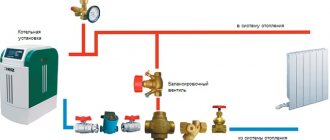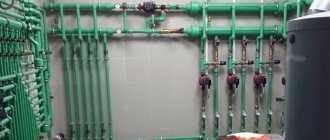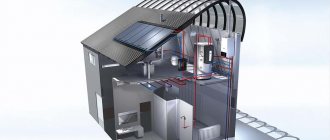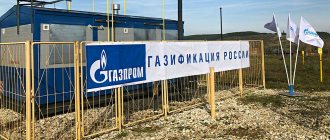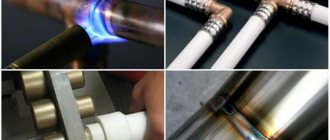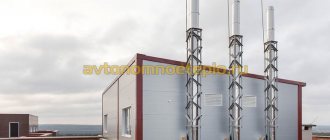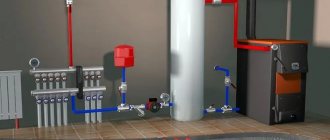Autonomous heating is a heating system, all of whose components are located directly in the heated room. The system consists of pipes connected to each other, connected to a heat source and radiators.
Do-it-yourself autonomous heating
That is, the operation of the system in question is based on the use of a boiler. Pipes are connected to it, they are routed in accordance with the requirements of a particular situation, the pipes themselves are connected to the radiators, and they already give off the bulk of the heat to the premises.
Do-it-yourself autonomous heating
To set up an autonomous heating system, boilers operating using different fuels can be used. Familiarize yourself with the main features of such a system, the advantages and disadvantages of each existing variety, study the instructions in the manual and proceed with installation. There is nothing complicated about setting up such heating yourself.
Boilers operating using different fuels
Modern heating systems
Only an experienced home craftsman can choose a suitable system and install it on his own. Most often, homeowners resort to the services of specialized companies whose specialists are able to make accurate calculations, as well as, using special tools and materials, install system components.
The most common coolant used for heating private homes is ordinary water. In regions with harsh winters, ethylene glycol or propylene glycol can also be used - non-freezing liquids that prevent pipes from freezing and the formation of ice plugs that stop the flow of coolant.
The water is brought to the required temperature using a boiler using available types of combustible materials. The most important task when choosing a heating system is to determine the least expensive type of fuel, as well as the optimal type of boiler, if we consider reliability and costs of purchase, installation and operation.
Autonomous heating system using electricity
The air in rooms can be brought to the desired condition not only with the help of radiators through which coolant circulates. Autonomous heating with electricity in a private house allows you to get rid of the purchase of flammable materials and the endless hassle of servicing the firebox.
Electric heating elements are able to bring the temperature in the house to the required value, while the machine will turn off the device in a timely manner, saving an expensive resource.
However, in this case, autonomy is achieved only partially, since any serious accident on power lines can leave the house without heat for a week, which is unacceptable in severe frost conditions.
Autonomous gas heating system
To avoid going broke on energy bills, many homeowners choose a natural gas system.
- Autonomous gas heating in a private house is carried out due to the supply of propane, a huge supply of which is stored in a gas holder.
- A voluminous metal tank is placed on the surface or underground next to the house. Gas enters the heating boiler through a pipe.
- The gas tank is refilled from a gas carrier once a year or less.
- Compared to other types of fuel boilers, heating with gas from a gas holder is characterized by minimal costs for replenishing fuel reserves, as well as the absence of daily labor costs to maintain the process in the system.
The gas enters the boiler under its own power, and the automation monitors its combustion without human intervention.
Natural circulation scheme
To understand the principle of operation of the gravity system, study the typical diagram used in two-story private houses. Combined wiring is implemented here: the supply and return of coolant occurs through two horizontal lines, connected by single-pipe vertical risers with radiators.
How gravity heating of a two-story house works:
- The specific gravity of the water heated by the boiler becomes smaller. The colder and heavier coolant begins to displace hot water upward and take its place in the heat exchanger.
- The heated coolant moves along a vertical collector and is distributed along horizontal lines laid with a slope towards the radiators. The current speed is low - about 0.1-0.2 m/s.
- Dividing through the risers, the water enters the radiators, where it successfully releases heat and cools. Under the influence of gravity, it returns to the boiler through a return manifold, which collects coolant from the remaining risers.
- The increase in water volume is compensated by an expansion tank installed at the highest point. Typically, the insulated container is located in the attic of the building.
Schematic diagram of gravity distribution with a circulation pump
In modern designs, gravity systems are equipped with pumps that accelerate circulation and heating of rooms. The pumping unit is placed on a bypass parallel to the supply line and operates when electricity is available. When the light is turned off, the pump is inactive, and the coolant circulates due to gravity.
Scope of application and disadvantages of gravity feeding
The purpose of the gravity circuit is to supply heat to homes without connection to electricity, which is important in remote regions with frequent power outages. The network of gravity pipelines and batteries can work together with any energy-independent boiler or stove (previously they said steam) heating.
Let's look at the negative aspects of using gravity:
- due to the low flow rate, it is necessary to increase the coolant flow by using large-diameter pipes, otherwise the radiators will not warm up;
- in order to “spur” natural circulation, horizontal sections are laid with a slope of 2-3 mm per 1 m of the highway;
- healthy pipes running under the ceiling of the second floor and above the floor of the first floor spoil the appearance of the rooms, which is noticeable in the photo;
- automatic control of air temperature is difficult - for batteries you need to buy only full-bore thermostatic valves that do not interfere with the convective circulation of the coolant;
- the scheme is unable to work with heated floors in a 3-story building;
- An increased volume of water in the heating network implies prolonged heating and high fuel consumption.
To fulfill requirement No. 1 (see the first section) in conditions of unreliable power supply, the owner of a two-story private house will have to bear the costs of materials - pipes of increased diameter and cladding for the manufacture of decorative boxes. The remaining disadvantages are not critical - slow heating is eliminated by installing a circulation pump, lack of efficiency - by installing special thermal heads on radiators and insulating pipes.
Design Tips
If you have taken the development of a gravity heating scheme into your own hands, be sure to consider the following recommendations:
- The minimum diameter of the vertical section coming from the boiler is 50 mm (meaning the internal size of the nominal diameter of the pipe).
- The horizontal distributing and collecting manifold can be reduced to 40 mm, before the last batteries - to 32 mm.
- A slope of 2-3 mm per 1 linear line of the pipeline is made towards the radiators on the supply and the boiler on the return.
- The inlet pipe of the heat generator should be located below the radiators on the first floor, taking into account the slope of the return line. It may be necessary to make a small pit in the boiler room to install a heat source.
- On the connections to heating devices on the second floor, it is better to install a direct bypass of small diameter (15 mm).
- Try to place the upper distribution manifold in the attic so as not to run under the ceilings of the rooms.
- Use an open-type expansion tank with an overflow pipe leading outside and not into the sewer. This makes it easier to monitor when the container is overfilled. The system will not work with a membrane tank.
The calculation and design of gravity heating in a cottage with a complex layout should be entrusted to specialists. And lastly: lines Ø50 mm or more will have to be made of steel pipes, copper or cross-linked polyethylene. The maximum size of metal-plastic is 40 mm, and the diameter of polypropylene will be simply menacing due to the thickness of the walls.
Advantages and disadvantages of an autonomous heating system
The very name of an autonomous heating system implies a refusal of low-quality and expensive services from third-party heat energy suppliers.
Thus, the owner of an autonomous heating system acquires the following advantages:
- Possibility to start and end the heating season in accordance with weather conditions.
- The power of the devices is manually controlled, which allows you to set a comfortable temperature in each room depending on the time of day.
- During periods of absence of people, the system can be turned off or configured to use resources economically.
- The dual-circuit circuit allows you to obtain not only heat, but also hot water for the kitchen and shower.
- The user gains complete freedom from the dictates of the heat supplier, his schedule for turning on and off the batteries. Homeowners become independent from accidents on heating mains and gas pipelines.
When choosing an autonomous heating system, one cannot ignore some of the disadvantages of its use:
- The home owner will have to constantly think about replenishing fuel supplies, looking for the best price, purchasing for future use, transporting and storing flammable materials near the house.
- If we are talking about a solid fuel boiler, you will need to manually load the fuel and remove the ash. Controlling the combustion process takes a lot of time.
- An individual heating system is a set of expensive devices and materials - a boiler, pipes, radiators, pumps, fittings and automatic controls.
- In the case of using electric heaters, the advantages of the choice are largely offset by huge electricity bills.
Pipes: what they are, how to choose
For the autonomous system to work properly, the pipes must withstand pressure of up to 2 atmospheres and liquid temperature of up to 95 degrees. They should last for decades and ensure tightness. For external pipes it is also good to have a decent appearance.
You can increase the thermal energy in a pipe by using pipes with a larger diameter, or by speeding up the movement of fluid. It must be remembered that excessively fast fluid movement creates hydraulic noise. This is extremely uncomfortable for life. Therefore, you cannot accelerate the movement more than 1.5 m/s. And knowledgeable plumbers do not recommend exceeding the 1 m/s mark. Making it below 0.25 m/s is also not advisable - there won’t be enough power to push through the air pockets.
In older houses, a system of steel pipes in combination with cast iron radiators was often used. This technology is outdated. New materials guarantee new characteristics. Which pipe materials are better?
- Metal-plastic – base made of aluminum composition, shell made of polyethylene. They are used in hot and cold water supply. Pros: tightness, good throughput, resistance to tearing.
Metal-plastic pipes
- Copper pipes have been used for 3 centuries and this material has proven itself well. Copper pipes are strong and durable and do not collapse for decades. For the shell, a layer of polyethylene or polyvinyl chloride is sometimes made on the outside.
Copper pipes
- Steel pipes are the most popular in the absence of alternatives. They are durable, have a low expansion coefficient, and are indispensable in heat supply and steam heating. Cons: the material is susceptible to corrosion.
Steel pipes
- Stainless steel pipes are made from alloy steel. Due to their durability and resistance to corrosion, they pay for themselves in several years, although they are not cheap. There is no need to frequently repair the pipeline or change its individual parts.
Stainless steel pipes
- Polypropylene pipes (PP or PPR) have moved from water supply to heat supply. PP pipes will last from 30 to 50 years. There is no corrosion on them. They are not afraid of aggressive components in the coolant composition.
Polypropylene pipes
The pipeline operates without failures if:
- Consider the heating system diagram before purchasing pipes;
- Calculate 4 parameters: required pipe diameter, heating system power, coolant speed, hydraulic calculation;
- Buy only from trusted manufacturers.
Types of systems
Autonomous heating systems differ according to the following characteristics:
- Type of combustible material. In the field of heating suburban housing, a wide variety of thermal energy generators are used, operating on all available types of combustible materials. This can be gasoline, fuel oil, kerosene, oil, fuel briquettes made from peat, sawdust, husks, corn cobs, hay, and straw. In areas where gas has not yet been supplied or where creating a connection to an existing gas pipeline is too expensive, propane is used, which is filled into the gas tank with a special machine.
- By type of energy. Combustion energy is used, electricity received from a centralized supplier or produced independently - using a diesel generator and solar panels.
- According to the type of transportation of coolant to radiators. The circulation of hot water can be organized according to a single-pipe or two-pipe scheme. A combined method can also be used.
- By type of heat generator. Boilers are used in which combustion energy is transferred to a coolant, which then releases heat to radiators. Electric convectors are also used to heat the air “on site”.
Boiler operating rules
If the boiler is an open type, then it must be installed on the floor, which is covered with a fireproof layer. If the room in which the boiler room is located has a small area, then it is necessary to provide an additional ventilation system. The chimney must provide the necessary draft, which is needed for normal combustion, so you need to take care of its arrangement in advance. By installing a stabilizer, you don’t have to worry about the traction not being at the proper level.
Boiler chimney diagram
Step-by-step instructions for beginners
Having no experience in matters of autonomous heating, it is better to give preference to electricity. Although the energy bill can boggle the mind, significant savings arise due to the ease of installation and operation of the device.
In any case, the development of the project and its implementation is carried out according to the following scheme:
- Calculate or order a heating system calculation from specialists.
- Add at least 20% margin to the calculated number of radiator sections. This will allow them to be used effectively throughout their entire service life, when the internal surfaces become coated.
- Radiators are being installed.
- The boiler is being installed.
- Pipes are run from the boiler to the radiators.
- Upon completion of installation, the system is tested for leaks.
If installation skills are not enough, it is better to invite an experienced locksmith, since you cannot allow the house to be flooded with hot water in winter.
Single pipe solution
heats up and rushes into the supply risers
There are two installation options. In the first case, part of the coolant passes into the radiators, the other fills the heat transfer devices located below. The water flow is adjusted as needed.
The flow-through option provides for the sequential movement of coolant through all radiators installed along the main pipe line. Unlike the first scheme, only cold water flows back. The flow system does not allow you to regulate the heating process.
The efficiency of an autonomous system is affected by the difference in pressure at the inlet and outlet. It is responsible for the speed of the coolant. Regarding the single-pipe connection diagram, it should be noted that the pressure is provided by the diameter of the pipes and the height of the collector at the starting point and its decrease at the final point.
Solar energy is the most economical. The resource can be obtained for free by installing the appropriate equipment - a battery, and heating it does not require degrees at all, but requires only sunlight. Another alternative type of energy is wind turbines. They are used in countries where there is little sun. It is possible that the benefits of natural energy will encourage you to experiment when the issue of energy availability arises.

